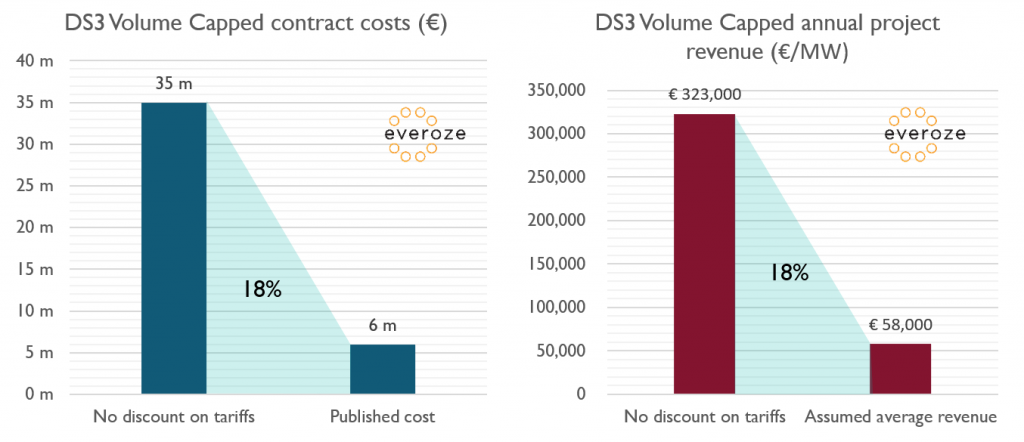Batteries in Ireland to provide frequency response for less than €60k per MW per year
Published Oct 2019
110MW of battery projects have been awarded 6 year DS3 contracts on the Island of Ireland at record low costs. In this blog, Everoze partner Benjamin Lock presents Everoze’s analysis on the numbers – and assesses where the storage market goes from here.
They made us wait for it.
But finally – a full month after bidders were notified – the results have been made public. On Thursday, EirGrid and SONI published the results of the DS3 Volume Capped procurement process.
But before we get into that, some context: DS3 is a multi-year programme designed to help meet Ireland’s renewable energy targets. A key stream of this programme is the procurement of services to ensure the electricity system is ready for world-leading levels of renewable energy penetration. This Volume Capped tender is the culmination of one of two procurement routes for these services. It offers 6 year contracts for fast acting response services and is ideally suited to the technical characteristics of battery energy storage systems.
Everoze has been tracking these procurement processes closely since their announcement. We’ve provided services to a range of players in the all-Island market, providing feasibility modelling, due diligence, drafting Employer’s Requirements and more.
So, while detail is somewhat lacking in EirGrid and SONI’s announcement, we have taken a stab at teasing out some thought provoking insights and assessing just what these tender results might mean.
Two winners, three projects
Three battery projects were successful, totaling 110 MW of capacity. The largest of these is Scottish Power Renewables’ 50 MW Gorman Energy Storage Station, which the Enduring Connection Policy 2018 offers list (ECP-1) will tell you is a project developed by RES and located in County Meath. The other two projects, Porterstown Battery Storage Facility and Kilmannock Battery Storage Facility are both 30 MW in size and listed under project specific SPVs, but are now part of Gore Street Capital’s growing energy storage portfolio, backed up with cash from The Republic of Ireland’s sovereign wealth fund. Congratulations to both SPR and Gore Street Capital on their success.
Rock-bottom bids
And what did the winners bid? Anyone familiar with DS3 will know that it’s rarely that simple. The Transmission System Operators (TSOs) have told us that the estimated total value of these contracts is around €6 m per year, totaling €38 m over the (6 year) duration of the contracts. This suggests an average revenue of just €58 k per MW per year. Making a few assumptions on scalars* suggests bids came in at approximately 18% of published tariff levels (on average). The cheapest project could have bid even lower.
Low prices were of course expected, but even so, the successful developers will have to squeeze their supply chains hard to deliver these services for less than €60 k/MW/yr. As well as cutting costs they will likely be looking for opportunities to boost their revenue, with the Capacity Remuneration Mechanism and the energy markets being the obvious targets.
Size matters
With no single project below 30 MW, and Gore Street Capital likely to make use of the increased buying power to be had by procuring their combined 60 MW from the same suppliers, the results of this tender suggest that economies of scale have a real impact on bids. The TSOs haven’t published the full list of 18 bidders, but of the identical number of developers who secured grid connections for DS3 projects through the ECP-1 process, over half were 20MW or below, and none of these were successful in the tender.
Watch for the unsuccessful projects
So, what’s next? For the winners, not so much. Yes, there are interim milestones to meet, but they have a leisurely two years to build – and try to negotiate down those EPC prices. So now it’s time to celebrate well-pitched bids and hard work that paid off.
Paradoxically, the ones with real activity now are the losers, not the winners. The alternative Volume Uncapped procurement route offers a riskier but potentially more rewarding opportunity. But speed is everything here: contracts could run until just 2023, and the more providers pile into the market, the more likely it is that the TSOs adjust the tariffs downwards to reduce their spend.
There’s also the possibility of a further Volume Capped tender. When this route was first announced the TSOs claimed they could use it to buy up to 300 MW of capacity. They’ve since kept very quiet on this original claim, but with just 110 MW secured through this first tender, and at such a cost saving to the consumer, it wouldn’t be surprising if discussions of a second Volume Capped tender were being rekindled in EirGrid Group HQ.
Competitive tenders deliver (again)
As the party that ultimately picks up the bill, it’s the consumer that’s the real winner here. These bids came in way below what the TSOs expected when first designing the procurement mechanism. They even say it themselves: rather than the €38 m cost of the competitive tenders “if the equivalent level of services were procured through the Volume Uncapped process, the value of the contracts would be approximately €210 million”. A competitive tender has delivered again, and shown just how cheaply batteries can provide the system services needed to take us towards a zero-carbon grid.
*Assuming a response speed of 0.15s, 100% availability and no performance penalties




